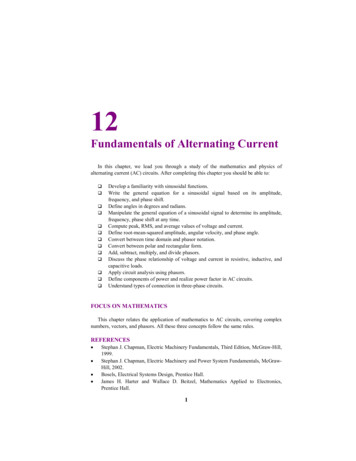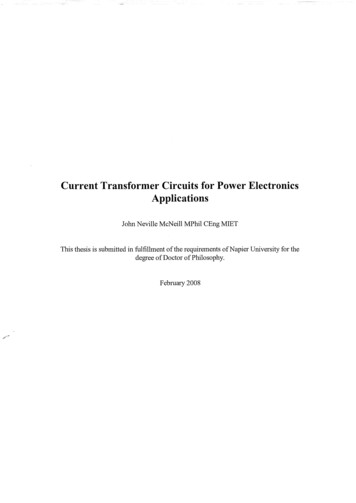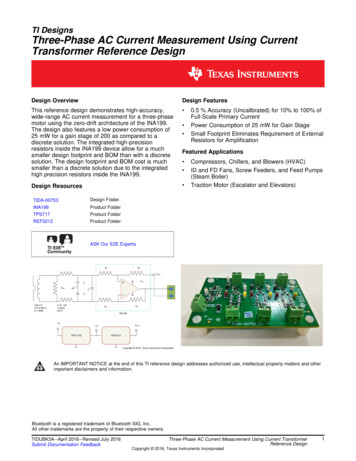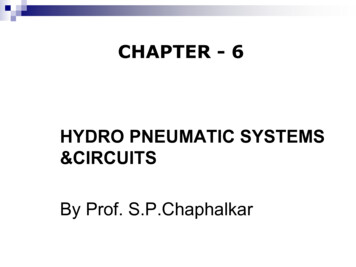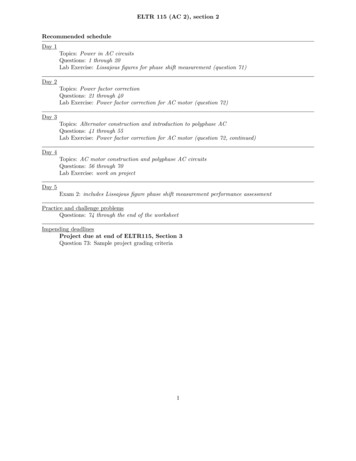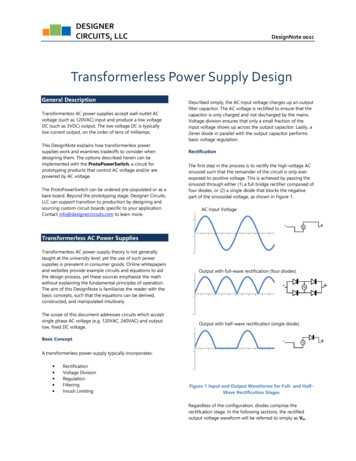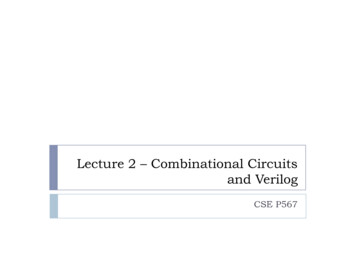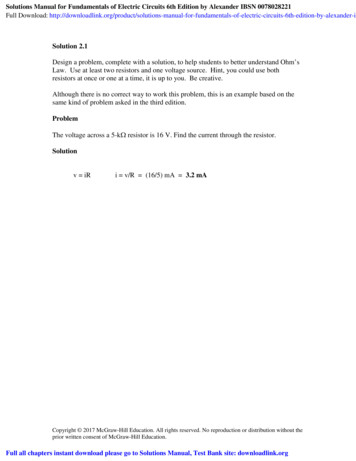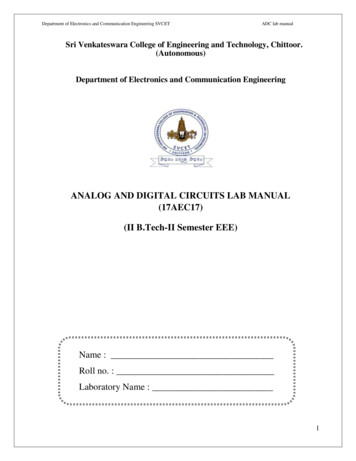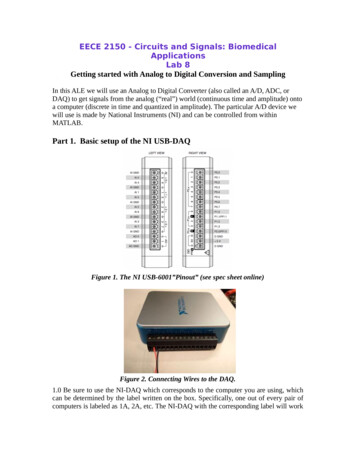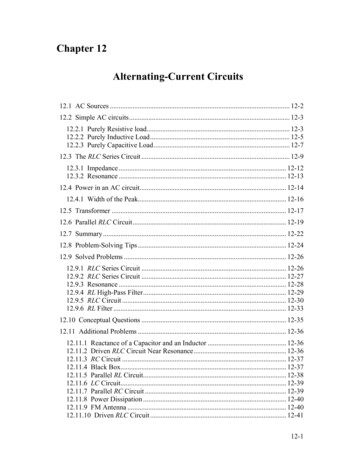
Transcription
Chapter 12Alternating-Current Circuits12.1 AC Sources . 12-212.2 Simple AC circuits. 12-312.2.1 Purely Resistive load. 12-312.2.2 Purely Inductive Load. 12-512.2.3 Purely Capacitive Load. 12-712.3 The RLC Series Circuit . 12-912.3.1 Impedance . 12-1212.3.2 Resonance . 12-1312.4 Power in an AC circuit. 12-1412.4.1 Width of the Peak. 12-1612.5 Transformer . 12-1712.6 Parallel RLC Circuit. 12-1912.7 Summary. 12-2212.8 Problem-Solving Tips . 12-2412.9 Solved Problems . 12-2612.9.112.9.212.9.312.9.412.9.512.9.6RLC Series Circuit . 12-26RLC Series Circuit . 12-27Resonance . 12-28RL High-Pass Filter. 12-29RLC Circuit . 12-30RL Filter . 12-3312.10 Conceptual Questions . 12-3512.11 Additional Problems . 12-3612.11.1 Reactance of a Capacitor and an Inductor . 12-3612.11.2 Driven RLC Circuit Near Resonance. 12-3612.11.3 RC Circuit . 12-3712.11.4 Black Box. 12-3712.11.5 Parallel RL Circuit. 12-3812.11.6 LC Circuit. 12-3912.11.7 Parallel RC Circuit . 12-3912.11.8 Power Dissipation . 12-4012.11.9 FM Antenna . 12-4012.11.10 Driven RLC Circuit . 12-4112-1
Alternating-Current Circuits12.1 AC SourcesIn Chapter 10 we learned that changing magnetic flux can induce an emf according toFaraday’s law of induction. In particular, if a coil rotates in the presence of a magneticfield, the induced emf varies sinusoidally with time and leads to an alternating current(AC), and provides a source of AC power. The symbol for an AC voltage source isAn example of an AC source isV (t ) V0 sin ωt(12.1.1)where the maximum value V0 is called the amplitude. The voltage varies between V0 and V0 since a sine function varies between 1 and 1. A graph of voltage as a function oftime is shown in Figure 12.1.1.Figure 12.1.1 Sinusoidal voltage sourceThe sine function is periodic in time. This means that the value of the voltage at time twill be exactly the same at a later time t ′ t T where T is the period. The frequency,f , defined as f 1/ T , has the unit of inverse seconds (s 1), or hertz (Hz). The angularfrequency is defined to be ω 2π f .When a voltage source is connected to an RLC circuit, energy is provided to compensatethe energy dissipation in the resistor, and the oscillation will no longer damp out. Theoscillations of charge, current and potential difference are called driven or forcedoscillations.After an initial “transient time,” an AC current will flow in the circuit as a response to thedriving voltage source. The current, written as12-2
I (t ) I 0 sin(ωt φ )(12.1.2)will oscillate with the same frequency as the voltage source, with an amplitude I 0 andphase φ that depends on the driving frequency.12.2 Simple AC circuitsBefore examining the driven RLC circuit, let’s first consider the simple cases where onlyone circuit element (a resistor, an inductor or a capacitor) is connected to a sinusoidalvoltage source.12.2.1 Purely Resistive loadConsider a purely resistive circuit with a resistor connected to an AC generator, as shownin Figure 12.2.1. (As we shall see, a purely resistive circuit corresponds to infinitecapacitance C and zero inductance L 0 .)Figure 12.2.1 A purely resistive circuitApplying Kirchhoff’s loop rule yieldsV (t ) VR (t ) V (t ) I R (t ) R 0(12.2.1)where VR (t ) I R (t ) R is the instantaneous voltage drop across the resistor. Theinstantaneous current in the resistor is given byI R (t ) VR (t ) VR 0 sin ωt I R 0 sin ωtRR(12.2.2)where VR 0 V0 , and I R 0 VR 0 R is the maximum current. Comparing Eq. (12.2.2) withEq. (12.1.2), we find φ 0 , which means that I R (t ) and VR (t ) are in phase with eachother, meaning that they reach their maximum or minimum values at the same time. Thetime dependence of the current and the voltage across the resistor is depicted in Figure12.2.2(a).12-3
Figure 12.2.2 (a) Time dependence of I R (t ) and VR (t ) across the resistor. (b) Phasordiagram for the resistive circuit.The behavior of I R (t ) and VR (t ) can also be represented with a phasor diagram, as shownin Figure 12.2.2(b). A phasor is a rotating vector having the following properties:(i) length: the length corresponds to the amplitude.(ii) angular speed: the vector rotates counterclockwise with an angular speed ω.(iii) projection: the projection of the vector along the vertical axis corresponds to thevalue of the alternating quantity at time t.GWe shall denote a phasor with an arrow above it. The phasor VR 0 has a constantmagnitude of VR 0 . Its projection along the vertical direction is VR 0 sin ωt , which is equalto VR (t ) , the voltage drop across the resistor at time t . A similar interpretation appliesGto I R 0 for the current passing through the resistor. From the phasor diagram, we readilysee that both the current and the voltage are in phase with each other.The average value of current over one period can be obtained as:I R (t ) I1 T1 T()Itdt I R 0 sin ωt dt R 0R 00TTT T0sin2π tdt 0T(12.2.3)This average vanishes becausesin ω t 1 Tsin ω t dt 0T 0(12.2.4)Similarly, one may find the following relations useful when averaging over one period:12-4
1 Tcos ωt dt 0T 01 Tsin ωt cos ωt sin ωt cos ωt dt 0T 01 T1 T1 2π t sin 2 ωt sin 2 ωt dt sin 2 dt 002TT T cos ωt cos 2 ωt (12.2.5)1 T1 T1 2π t 2coscos 2 tdt ω dt 002TT T From the above, we see that the average of the square of the current is non-vanishing:I R2 (t ) 1 T 21 T1 T1 2π t I R (t )dt I R2 0 sin 2 ωt dt I R2 0 sin 2 dt I R2 0 2T 0T 0T 0 T (12.2.6)It is convenient to define the root-mean-square (rms) current asI R02In a similar manner, the rms voltage can be defined asI rms I R2 (t ) Vrms VR2 (t ) VR 02(12.2.7)(12.2.8)The rms voltage supplied to the domestic wall outlets in the United States isVrms 120 V at a frequency f 60 Hz .The power dissipated in the resistor isPR (t ) I R (t ) VR (t ) I R2 (t ) R(12.2.9)from which the average over one period is obtained as:2Vrms1 22PR (t ) I (t ) R I R 0 R I rms R I rmsVrms 2R2R(12.2.10)12.2.2 Purely Inductive LoadConsider now a purely inductive circuit with an inductor connected to an AC generator,as shown in Figure 12.2.3.12-5
Figure 12.2.3 A purely inductive circuitAs we shall see below, a purely inductive circuit corresponds to infinite capacitanceC and zero resistance R 0 . Applying the modified Kirchhoff’s rule for inductors,the circuit equation readsV (t ) VL (t ) V (t ) LdI L 0dt(12.2.11)which impliesdI L V (t ) VL 0sin ωt dtLL(12.2.12)where VL 0 V0 . Integrating over the above equation, we findI L (t ) dI L VL 0π V V sin ωt dt L 0 cos ωt L 0 sin ωt L2 ωL ωL (12.2.13)where we have used the trigonometric identityπ cos ω t sin ω t 2 (12.2.14)for rewriting the last expression. Comparing Eq. (12.2.14) with Eq. (12.1.2), we see thatthe amplitude of the current through the inductor isI L0 VL 0 VL 0 ωL X L(12.2.15)whereX L ωL(12.2.16)is called the inductive reactance. It has SI units of ohms (Ω), just like resistance.However, unlike resistance, X L depends linearly on the angular frequency ω. Thus, theresistance to current flow increases with frequency. This is due to the fact that at higher12-6
frequencies the current changes more rapidly than it does at lower frequencies. On theother hand, the inductive reactance vanishes as ω approaches zero.By comparing Eq. (12.2.14) to Eq. (12.1.2), we also find the phase constant to beφ π2(12.2.17)The current and voltage plots and the corresponding phasor diagram are shown in theFigure 12.2.4 below.Figure 12.2.4 (a) Time dependence of I L (t ) and VL (t ) across the inductor. (b) Phasordiagram for the inductive circuit.As can be seen from the figures, the current I L (t ) is out of phase with VL (t ) by φ π / 2 ;it reaches its maximum value after VL (t ) does by one quarter of a cycle. Thus, we say thatThe current lags voltage by π / 2 in a purely inductive circuit12.2.3 Purely Capacitive LoadIn the purely capacitive case, both resistance R and inductance L are zero. The circuitdiagram is shown in Figure 12.2.5.Figure 12.2.5 A purely capacitive circuit12-7
Again, Kirchhoff’s voltage rule impliesV (t ) VC (t ) V (t ) Q(t ) 0C(12.2.18)which yieldsQ(t ) CV (t ) CVC (t ) CVC 0 sin ωt(12.2.19)where VC 0 V0 . On the other hand, the current isI C (t ) dQπ ωCVC 0 cos ωt ωCVC 0 sin ωt dt2 (12.2.20)where we have used the trigonometric identityπ cos ω t sin ω t 2 (12.2.21)The above equation indicates that the maximum value of the current isI C 0 ωCVC 0 VC 0XC(12.2.22)whereXC 1ωC(12.2.23)is called the capacitance reactance. It also has SI units of ohms and represents theeffective resistance for a purely capacitive circuit. Note that X C is inversely proportionalto both C and ω , and diverges as ω approaches zero.By comparing Eq. (12.2.21) to Eq. (12.1.2), the phase constant is given byφ π2(12.2.24)The current and voltage plots and the corresponding phasor diagram are shown in theFigure 12.2.6 below.12-8
Figure 12.2.6 (a) Time dependence of I C (t ) and VC (t ) across the capacitor. (b) Phasordiagram for the capacitive circuit.Notice that at t 0 , the voltage across the capacitor is zero while the current in the circuitis at a maximum. In fact, I C (t ) reaches its maximum before VC (t ) by one quarter of acycle ( φ π / 2 ). Thus, we say thatThe current leads the voltage by π/2 in a capacitive circuit12.3 The RLC Series CircuitConsider now the driven series RLC circuit shown in Figure 12.3.1.Figure 12.3.1 Driven series RLC CircuitApplying Kirchhoff’s loop rule, we obtainV (t ) VR (t ) VL (t ) VC (t ) V (t ) IR LdI Q 0dt C(12.3.1)which leads to the following differential equation:12-9
LdIQ IR V0 sin ωtdtC(12.3.2)Assuming that the capacitor is initially uncharged so that I dQ / dt is proportional tothe increase of charge in the capacitor, the above equation can be rewritten asLd 2QdQ Q R V0 sin ω t2dtdt C(12.3.3)One possible solution to Eq. (12.3.3) isQ(t ) Q0 cos(ω t φ )(12.3.4)where the amplitude and the phase are, respectively,Q0 V0 / L( Rω / L) 2 (ω 2 1/ LC ) 2 V0ω R 2 (ω L 1/ ω C )2V0(12.3.5)ω R 2 ( X L X C )2andtan φ 1 1 X L XC ω L R Rω C (12.3.6)dQ I 0 sin(ωt φ )dt(12.3.7)The corresponding current isI (t ) with an amplitudeI 0 Q0ω V0R 2 ( X L X C )2(12.3.8)Notice that the current has the same amplitude and phase at all points in the series RLCcircuit. On the other hand, the instantaneous voltage across each of the three circuitelements R, L and C has a different amplitude and phase relationship with the current, ascan be seen from the phasor diagrams shown in Figure 12.3.2.12-10
Figure 12.3.2 Phasor diagrams for the relationships between current and voltage in (a)the resistor, (b) the inductor, and (c) the capacitor, of a series RLC circuit.From Figure 12.3.2, the instantaneous voltages can be obtained as:VR (t ) I 0 R sin ω t VR 0 sin ω tπ VL (t ) I 0 X L sin ω t VL 0 cos ω t2 (12.3.9)π VC (t ) I 0 X C sin ω t VC 0 cos ω t2 whereVR 0 I 0 R,VL 0 I 0 X L ,VC 0 I 0 X C(12.3.10)are the
effective resistance for a purely capacitive circuit. Note that XC is inversely proportional to both C and ω , and diverges as ω approaches zero. By comparing Eq. (12.2.21) to Eq. (12.1.2), the phase constant is given by 2 π φ (12.2.24) The current and voltage plots and the corresponding phasor diagram are shown in the Figure 12.2.6 .
